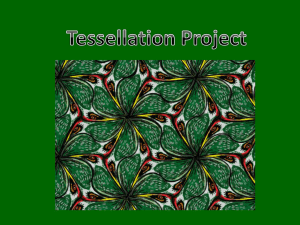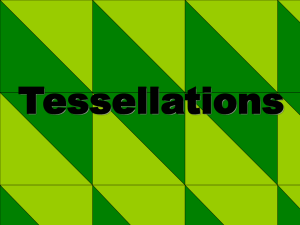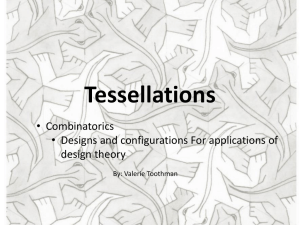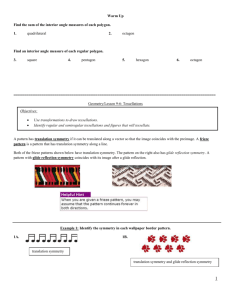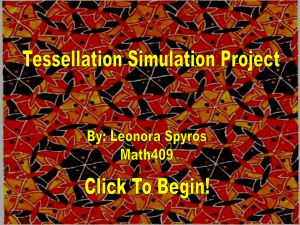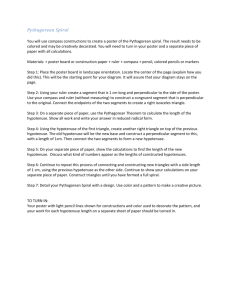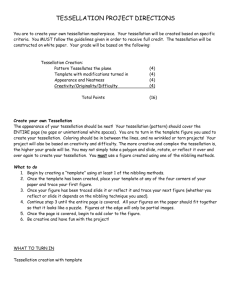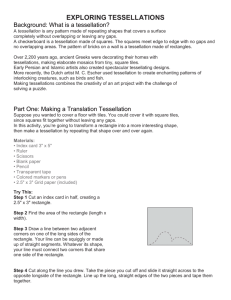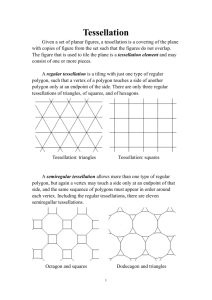May 17 handout
advertisement
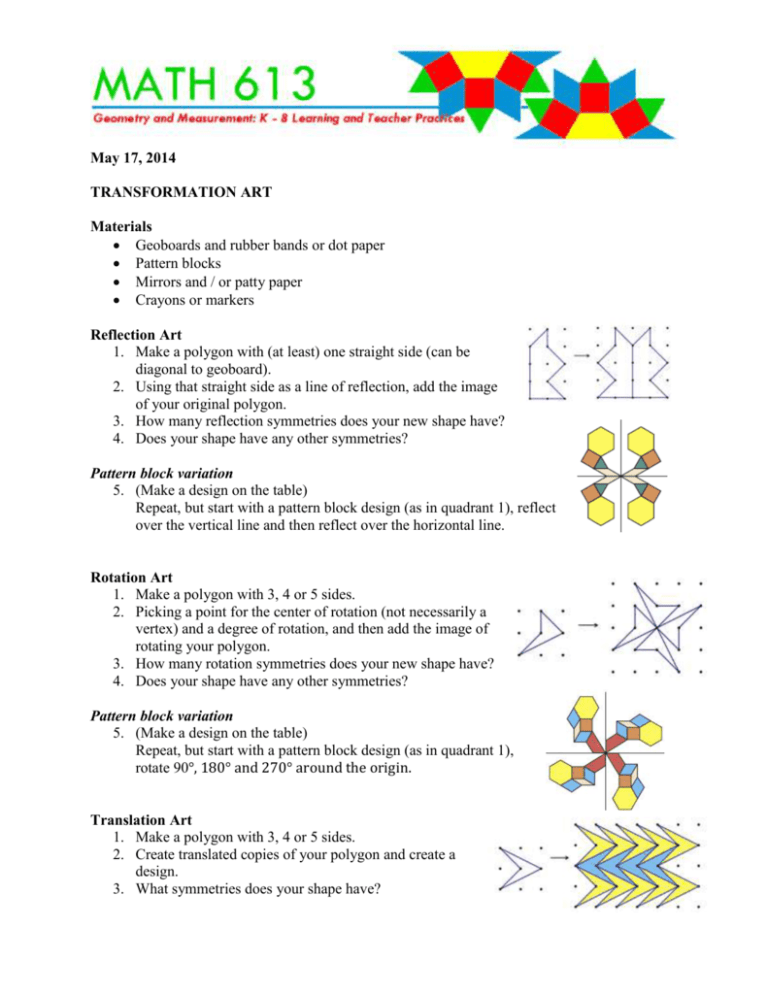
May 17, 2014 TRANSFORMATION ART Materials Geoboards and rubber bands or dot paper Pattern blocks Mirrors and / or patty paper Crayons or markers Reflection Art 1. Make a polygon with (at least) one straight side (can be diagonal to geoboard). 2. Using that straight side as a line of reflection, add the image of your original polygon. 3. How many reflection symmetries does your new shape have? 4. Does your shape have any other symmetries? Pattern block variation 5. (Make a design on the table) Repeat, but start with a pattern block design (as in quadrant 1), reflect over the vertical line and then reflect over the horizontal line. Rotation Art 1. Make a polygon with 3, 4 or 5 sides. 2. Picking a point for the center of rotation (not necessarily a vertex) and a degree of rotation, and then add the image of rotating your polygon. 3. How many rotation symmetries does your new shape have? 4. Does your shape have any other symmetries? Pattern block variation 5. (Make a design on the table) Repeat, but start with a pattern block design (as in quadrant 1), rotate 90°, 180° and 270° around the origin. Translation Art 1. Make a polygon with 3, 4 or 5 sides. 2. Create translated copies of your polygon and create a design. 3. What symmetries does your shape have? TRIANGLE ART Wheel of Theodorus Materials Index cards Straightedge Crayons or markers 1. Mark equal lengths on two adjacent sides of an index card. 2. Use the index card to mark the two legs of an isosceles right triangle and use the straightedge to add the hypotenuse. 3. Place the index card so that one side of the right angle lies on the hypotenuse of the first triangle, and sketch in the next triangle leg. 4. Repeat, adding right triangles with one leg the “index card unit” and one leg the previous hypotenuse. Question: What are the exact lengths of the hypotenuse of each triangle that you added? Question: Are there any symmetries in this quilt? Question: What polygons can you see in this quilt? TRIANGLE ART They Pythagorean Triples Quilt\ Materials Graph and different colored paper Straightedge Glue stick 1. On graph paper, draw patterns for each of these triangles 3–4–5 5 – 12 – 13 7 – 24 – 25 9 – 40 - 41 2. Trace around your patterns and cut out four copies of each triangle from your choice of colored paper and four copies of each of your triangles from white paper. 3. Start with the smallest set of colored triangles, and arrange them so they form a square, with a 1-unit square in the center. Glue them down. 4. Now place the smallest white triangles around the square of colored triangles to create another square. Glue them down. 5. Continue with the next largest colored, then white triangles, each time making a square. Question: How are you able to make a square each time? Question: Are there any symmetries in this quilt? Question: What polygons can you see in this quilt? TESSELLATION ART Materials Index cards, scissors and tape OR patty paper Crayons or markers Translation Tessellation Directions: How to make a Translation Tessellation The rectangle in figure a tessellates. In figure b, one side of the rectangle is modified by a jagged line design. The design is then translated to the opposite side of the rectangle as a modification in figure c. Explain why the new shape in figure c will also tessellate the plane. In figure d, one of the remaining parallel sides of the rectangle is altered by a different design. This design is then translated to the opposite side in figure e, producing the final shape in figure f. The tessellation formed by the modified rectangle is shown in Figure 1. This tessellation becomes an Escher-type drawing when details and/or color are added to the basic design. In Figure 2, the tessellation has been rotated 90° and a few details have been added to make a simple Escher-type drawing. Make a Translation Tessellation Starting with a rectangle, a rhombus or a square, make your own Translation Tessellation. You can cut and tape an index card to make a template or you can use patty paper. Rotation Tessellation Directions: How to make a Rotation Tessellation The figures illustrate the modification and rotation of the sides of an equilateral triangle. First, side AB is modified as in figure a. Then the design is rotated about vertex A to adjacent side AC, as shown in figure b, so that vertex B is mapped onto vertex C. Side BC can be modified by rotating a design about its midpoint. In figure c, a design is created between the midpoint M and vertex C. The pattern is completed by rotating this design 180° about midpoint M so that vertex C is mapped onto vertex B, as shown in figure d. This pattern was used to create the following tessellation. Notice that this tessellation can be mapped onto itself by rotations about certain vertex points. Make a Rotation Tessellation Starting with a triangle, a square or a hexagon, make your own Rotation Tessellation. You can cut and tape an index card to make a template or you can use patty paper. Note, if you have an even number of sides, you can rotate one side about a vertex to the adjacent side (as in figures a and b) OR you can rotate a design on half of a side about the midpoint of the side (as in figures c and d). Glide-Reflection Tessellation Directions: How to make a Glide-Reflection Tessellation A glide reflection can be used to create a tessellating figure from parallelogram ABCD. Side AD is modified in figure a, and the design is translated to side BC in figure b. (The glide) Next, side DC is modified as shown in figure c. The design on DC is then translated to side AB, as shown in figure d. Finally, the design along side AB is reflected about a line, perpendicular to the midpoint of AB, as illustrated in figure e. The two motions (translation followed by reflection) shown in figures d and e produce a glide reflection. The pattern created above in figures a–f was used to form the following tessellation. What single mapping will map each row of this tessellation onto the row below it? Make a Glide-Reflection Tessellation Starting with a parallelogram, make your own Glide-Reflection Tessellation. You can cut and tape an index card to make a template or you can use patty paper.

